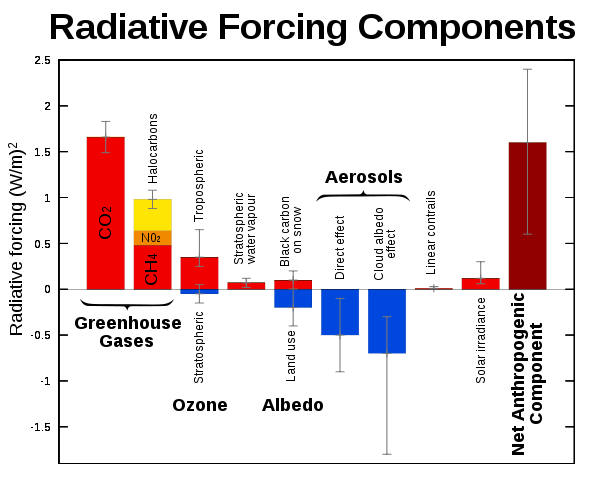 |
This is a file from the Wikimedia Commons. Information from its description page there is shown below.
Commons is a freely licensed media file repository. You can help.
|
Summary
| Description |
Global average radiative forcing estimates and ranges in 2005 for anthropogenic greenhouse gases and other important agents and mechanisms. Understanding global warming requires understanding the changes in climate forcings that have occurred since the industrial revolution. These include positive forcing from increased greenhouse gases, negative forcing from increased sulphate aerosols and poorly constrained forcings from indirect aerosol feedbacks as well as minor contributions from solar variability and other factors. The poorly constrained aerosol effects results from both limited physical understanding of how aerosols interact with the atmosphere and limited knowledge of aerosol concentrations during the pre-industrial period. This is a significant source of uncertainty in comparing modern climate forcings to past states. Contrary to the impression given by this figure, it is not possible to simply sum the radiative forcing contributions from all sources and obtain a total forcing. This is because different forcing terms can interact to either amplify or interfere with each other. For example, in the case of greenhouse gases, two different gases may share the same absorption bands thus partially limiting their effectiveness when taken in combination. |
| Date |
|
| Source |
The figures used to generate this plot were obtained from the IPCC Working Group I Fourth Assessment Report Summary for Policymakers, page 16. |
| Author |
This figure was produced by Leland McInnes ( Radiative-forcings.svg) using gnuplot and Inkscape and is licensed under the GFDL. All data is from publicly available sources. |
Permission
( Reusing this file) |
Leland McInnes at the English language Wikipedia, the copyright holder of this work, hereby publishes it under the following license:
 |
Permission is granted to copy, distribute and/or modify this document under the terms of the GNU Free Documentation License, Version 1.2 or any later version published by the Free Software Foundation; with no Invariant Sections, no Front-Cover Texts, and no Back-Cover Texts. A copy of the license is included in the section entitled GNU Free Documentation License. http://www.gnu.org/copyleft/fdl.htmlGFDLGNU Free Documentation Licensetruetrue
|
|
|
File usage
The following pages on Schools Wikipedia link to this image (list may be incomplete):
This file contains additional information, probably added from the digital camera or scanner used to create or digitize it. If the file has been modified from its original state, some details may not fully reflect the modified file.
Through Schools Wikipedia, SOS Children has brought learning to children around the world. SOS Children's Villages works in 133 countries and territories across the globe, helps more than 62,000 children, and reaches over 2 million people in total. If you'd like to help, learn how to sponsor a child.



